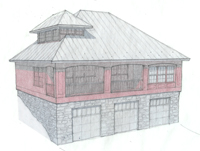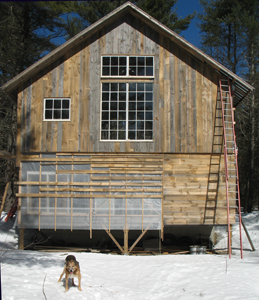I am involved with a project that is currently in the trimming out phase. This is the point where, if all goes well, the client and the builder can really see what I was blathering on about months ago. The owner is having some "aha!" moments and really appreciating the back and forth of the design process and the builder is humming along comfortable in making decisions and enjoying doing good work. Of course with the warm weather and the snow finally gone here in Vermont and no bugs yet, I think it would be hard not to be happy. Gotta go work on the garden. We get a substantial portion of our food year round from our own garden.
I guess I’ll never be a rich architect
There is an article in the summer 2008 “Fine Homebuilding” entitled “How to Afford an Architect” by Duo Dickinson. A good article if you ignore the super high percentage of construction cost fee numbers he uses. I have heard of (st)architects getting 12% to 15% of construction costs but 16% to 18% and 60 to 80 drawings for a house? Get real Duo! That’s why people are scared of hiring architects. I doubt I could design a house complicated enough to require even 40 drawings! I think I did 18 once…Of course, maybe I’m going about this all wrong.
Perry Road Project
 okay, enough talk, lets see pictures. This is a house that I have just finished tuning and tweaking. Construction will start next month. see my website for more information. We may set up an independant blog for this project. We are going for LEED certification and of course, Energy Star. We are pushing the low cost limits as well. I designed it so that the owners can do most of the labor without getting into too much time and complexity. Materials and subs costs are coming in at a little over $50 per square foot not including site work, well and septic. The shell is made of structural insulated panels from Foard Panel.
okay, enough talk, lets see pictures. This is a house that I have just finished tuning and tweaking. Construction will start next month. see my website for more information. We may set up an independant blog for this project. We are going for LEED certification and of course, Energy Star. We are pushing the low cost limits as well. I designed it so that the owners can do most of the labor without getting into too much time and complexity. Materials and subs costs are coming in at a little over $50 per square foot not including site work, well and septic. The shell is made of structural insulated panels from Foard Panel.
Oh, and of course, being in Vermont, there is a sleeping porch.
I am a Purist
I am a purist, architecturally speaking.
When the subject of style comes up people usually have very firm ideas in their heads. For years it seemed that everyone building their house in Vermont wanted a “cape”…with big windows and lots of light and an open floor plan. Talk about contradicting ones self. People tend to be as conservative architecturally in Vermont as they are socially liberal. Clapboard capes and Greek revivals are certainly not the most economical houses to construct either. I have done my share and I’ve done them well without too much compromising of my purist sensibilities. What I mean by this is that I like a lot of house styles but in reviewing houses that I really responded to emotionally over the years the common theme was that they were not trying to be something they weren’t. Capes trying to live like ranches, neo-victorians with cutesy plastic trim, developer subdivision type houses with layered gables on the front façade for no other reason than to attempt to reduce the scale of the house. I despise fakery of that sort. This reaction of mine applies to other things architectural as well. Concrete trying to look like stone, vinyl trying to look like wood, ceramic tile trying to look like stone or clay tiles, and (sound of “Psycho” violins) distressed wood cabinetry. Legitimacy of materials as well as style is important.
Some thoughts to live by in this industry and beyond:
1. Good, Cheap, Fast – choose two.
2. Rather than thinking “ How can I get everything I want for $xxx.xx?”
Think “ How much of what I want can I get for $xxx.xx?” the first question is usually and unsolvable equation. The second equation can result in some pleasant surprises.
The first is a notion that I have been applying to different situations for many years and have yet to be disappointed. The second is an attitude that I have run into recently on several projects and this is the first time I've put words to it.
Site Decisions and Instinct

Grassroots Modern, Carpenter Modern
Living in an aesthetically conservative state as I do, I am led to wonder what is it about modernism that scares people? After all, everybody loves their tiny simple I-Pod and their swoopy sleek cars and fancy footwear (except during mud season). Maybe modernism is still stuck with the images of white, cubist flat roofed houses that leak. Perhaps a survey is in order: what does modernism mean to you? As an architect I get to look at many magazines and books that are filled with warm, easy to live in modernist houses with amazing spaces and light but most of these houses are way beyond the budget of normal people. Dwell magazine comes as closest to the mark although they make regular forays into the high end of modernism as well. As a carpenter I realized that most carpenters are modernist at heart though few realize it. What is the simplest, cleanest way of doing something that results in something that works well and looks beautiful? - Actually bicycle design comes to mind here but this is a common carpentery way of looking at things. I use the term “carpenter modern” sometimes to describe the low budget modern aesthetic that I love so much – see my barn in a previous post. True, a lot of modern architecture is sleek and expensive and impossible to live in but great for displaying artwork. But carpenter modern is a grassroots modernism that seems to be about doing more with less and doing it better. Simplify the detailing, make the plan perfect – inside and out. Play with light. Play with views. Work with the seasons. Make the house as energy efficient as possible. Make it as low maintenance as possible. Make it as low budget as possible so you can splurge on the glass tile in the shower or a little more room in the plan for a bigger pantry instead of architectural shingles or fancy trim or gables on gables on gables which the all plan books seem to be full of nowadays. Window placement does not have to be a compromise between inside and outside. When all this is accomplished, then look at making it a cohesive aesthetic package, work the proportions and detailing to perfection. It is okay to do something just because it is cool. Architecture should be fun. Have no regrets when it is built. (Hopefully you get a client who understands the importance of these things because this takes time and time is money.) I like to design houses that people fall in love with. I like to walk into a house I designed with someone who hasn’t seen it yet and watch their jaw drop. I like that moment when someone realizes that this is what it’s all about.
FSC wood and blood on your hands
Uh oh, here I go getting political, in a semi-architectural way at least. I guess this is why I titled my blog "musings and mutterings" Don't buy non FSC certified hardwood such as mahogany. If you buy even one board, you have blood and exploitation on your hands. Yes, what you don't know may not hurt you but it may kill someone else. As Americans we are conditioned to turn a blind eye to issues of man's inhumanity to man in other areas of the world but please do what you can when you can and this is an easy one. Learn more: the Amazon Conservation Association and The Nature Conservancy
I also get much news and information from The Environmental News Network. Read this also for information on why you should avoid soy based foods and lots of information on cutting edge green building technologies. I also read Discover Magazine and National Geographic Magazine.
Just the Garage
 The vey cute garage of a large house I'm working on. You can see other parts of the house at my website
The vey cute garage of a large house I'm working on. You can see other parts of the house at my website
Grumpy Architect Time
It may be interesting to know where I come from and how it shapes my work. I grew up in rural Maine. I had friends who lived in houses with no running water, I never knew anyone with more than one bathroom in their house until I went to college, There was usually more than one kid to a bedroom. In the winter I walked the frozen shore line of the nearby lake, peaking into the windows of summer camps owned by the out-of-staters. In the summer, local kids worked 40 hours a week at the camps attended by kids from wealthy Massachusetts families and in the winter many of them worked 20 hours a week after school. I left Maine and attended college with kids who had gone to these summer camps, kids who had never held jobs. Culture Shock. Now I am comfortable in both worlds but I don’t feel that I truly belong to either. I definitely get uncomfortable when a client wants and can afford excess. I chomp at the bit when people “need” more than a one to one ratio of bums to toilets. Isn’t a 10 by 12 bedroom plenty big enough for little Johhny? A special room just to watch tv? On the other hand I love to design large homes that can accommodate several adults and packs of kids of all ages. A 10 by 12 pantry doesn’t seem so excessive to me and even sounds a bit small for a mudroom. Two sinks and two ovens in the kitchen? Why not! A 6 x 6 shower? Yes please and can I put the hot tub partly under the roof for when it snows? Can I heat it with solar panels on that roof? Sigh. These are some of the things that I think about while trying to be a brilliant up and coming young architect.
me
 I just corrected some links on my website that send people to my blog - (they didn't)
I added this head shot of me to my blog because a magazine just requested it. I'm gonna be famous!
I just corrected some links on my website that send people to my blog - (they didn't)
I added this head shot of me to my blog because a magazine just requested it. I'm gonna be famous!
The True Measure of Good Design
I listened with interest and a level of cynicism to an NPR interview of a bunch of high school kids touring the solar decathalon houses on the Washington Mall this summer. They loved the houses, which were clearly modernist in design, and could happily envision themselves living in such a house. I say cynicism because in ten years when they are looking for their first house to buy, I bet they will be looking for something "phony colony" or "neo-traditional"(Architectural anachronisms) in a garage door dominated subdivision. These kids will grow up and get conservative. Or maybe not. I have been encouraged recently to hear that the baby boomer's kids are not neccessarily looking for houses like they grew up in. Green design is in, cool modern aesthetics are in, smaller footprints and better floor plans are in. natural light is important, neighborhood is important and not just for the quality of the local schools. A good measure of design is "would a twelve year old think it's cool?" This works for houses just as much as other forms of design such as automobiles and electronics.
Passive Solar, Super-insulated...heat system?
Houses are getting too complicated. There are many people living in New England in houses that are warm and comfortable and only heat with wood and passive solar. My friend Steve is such a person. His house was built in the early eighties with large windows on the south and a descent amount of insulation by eighties standards. The temperature in his house is always 70 degrees in the winter even though he usually only fires up the wood stove a couple times per day. He uses no other heat source. When you build a new house at any budget level, it seems to be not a question that there is a significant heat system. As an architect, I periodically go to seminars on super-insulated passive solar houses where I hear that radiant heat is overkill and that you should consider a simple type of electric (future photovoltaics) backup heat near the plumbing (but you may never use it). No heat system, radiant or otherwise is a very hard sell as an architect. Maybe I should take people to Steve's house and let him be the salesman.
Hiring an Architect
I tooled around the web and found a few informative sites relating to hiring an architect. Bob Vila.com, eHow, and Contractors.com Add these to my post "A Good Architect" and it should say about ninety percent of what I would say if left to ramble on for an hour or so. I like potential clients to call people who I have recently worked with to get a sense of what I do. Few people have any idea how involved it can be and why it's so worth it.
Three Types of Builders
I have often said that there are three types of builders. The first is the craftsman who does amazing finish work and is really more of an artist than a builder. These folks sometimes end up building a whole house but would probably be happier doing custom cabinetry. The second is the most common. These are builders who treat building as work, a job taught to them by their mentors. They are often stuck doing building methods that are somewhat out of date. A classic example of this is putting clapboards directly over building paper wrapped sheathing. Most of the time this works okay and they can get away with it. The third type of builders treat building as a profession melding art, science and craftsmanship. They read a multitude of professional journals, go to building conferences and network with other builders. These folks know that there is a lot of work currently being done around the northeast to repair buildings constructed in the eighties and nineties with clapboards that were not back-primed and installed over a rain screen to space it out from the building paper and sheathing, preventing moisture from escaping. These builders are willing to learn and adapt to the rapidly changing building industry. These builders drive the evolution of the building industry.
Bob's Barn
 Here is a view of my barn so far. I am gradually building it to house my studio in the loft which will be super-insulated and heated with a wood stove and maybe a solar air heating panel to the right of the big windows. The big windows are out of an old factory and will have to be weather-stripped. I will also add polycaronate interior shutters and a big heavy curtain to draw at night. Downstairs left and center, I covered the studs with a greenhouse poly and I'm putting slatted siding over this with screws. El-cheapo moderist detailing that makes for a beautiful storage room inside.
April 4 note: I have spent $13,600 so far and will probably double that when all is said and done.
Here is a view of my barn so far. I am gradually building it to house my studio in the loft which will be super-insulated and heated with a wood stove and maybe a solar air heating panel to the right of the big windows. The big windows are out of an old factory and will have to be weather-stripped. I will also add polycaronate interior shutters and a big heavy curtain to draw at night. Downstairs left and center, I covered the studs with a greenhouse poly and I'm putting slatted siding over this with screws. El-cheapo moderist detailing that makes for a beautiful storage room inside.
April 4 note: I have spent $13,600 so far and will probably double that when all is said and done.
Slow Home movement
is an international movement devoted to bringing good design into real life. It takes its name from the slow food movement which arose as a reaction to the processed food industry. The sprawl of cookie cutter housing that surrounds us is like fast food - standardized, homogenous, and wasteful. It contributes to a too fast life that is bad for us, our cities, and the environment. In the same way that slow food raises awareness of the food we eat and how these choices affect our lives, Slow Home provides design focused information to empower each of us to take more control of our homes and improve the quality of where and how we live.
1. GO INDEPENDENT
Avoid homes by big developers and large production builders. They are designed for profit not people. Work with independent designers and building contractors instead.
2. GO LOCAL
Avoid home finishing products from big box retailers. The standardized solutions they provide cannot fit the unique conditions of your home. Use local retailers, craftspeople, and manufacturers to get a locally appropriate response and support your community.
3. GO GREEN
Stop the conversion of nature into sprawl. Don’t buy in a new suburb. The environmental cost can no longer be justified. Re-invest in existing communities and use sustainable materials and technologies to reduce your environmental footprint.
4. GO NEAR
Reduce your commute. Driving is a waste of time and the new roads and services required to support low density development is a big contributor to climate change. Live close to where you work and play.
5. GO SMALL
Avoid the real estate game of bigger is always better. A properly designed smaller home can feel larger AND work better than a poorly designed big one. Spend your money on quality instead of quantity.
6. GO OPEN
Stop living in houses filled with little rooms. They are dark, inefficient, and don’t fit the complexity of our daily lives. Live in a flexible and adaptive open plan living space with great light and a connection to outdoors.
7. GO SIMPLE
Don’t buy a home that has space you won’t use and things you don’t need. Good design can reduce the clutter and confusion in your life. Create a home that fits the way you really want to live.
8. GO REAL
Avoid fake materials and the re-creation of false historical styles. They are like advertising images and have little real depth. Create a home in which character comes from the quality of space, natural light and the careful use of good, sustainable materials.
9. GO HEALTHY
Avoid living in a public health concern. Houses built with cheap materials off gas noxious chemicals. Suburbs promote obesity because driving is the only option. Use natural, healthy home materials and building techniques. Live where you can walk to shop, school and work.
10. GO FOR IT
Stop procrastinating. The most important, and difficult, step in the slow home process is the first one that you take. Get informed and then get involved with your home. Every change, no matter how small, is important.
House Size, Square Foot Costs and Economy of Materials
or: Size Matters
I have some issues with the idea of building small which I will see if I can explain. I really appreciate Sarah Susanka’s book “The Not So Big House” but most of the houses she illustrates the book with are still fairly large. Yes, 2500 square feet instead of 4500 square feet is a good thing but it is still rather large and the jogs in plan and overly complicated roofs that many plans use to reduce the raw square footage seem wasteful.
Lets assume that you are at least meeting and hopefully exceeding energy codes. (remember these codes represent the bare minimum! - Vermont has an energy code although there is no residential building code in most towns) A simpler plan that is 20% bigger is not going to cost 20% more to heat and/or cool and it may even cost less. A simple form may also use fewer raw materials or at least result in less waste. Simple forms, particularly ones that have cleaner roof lines, are less likely to need renovation and repair in the long run.
I also like the idea of designing as much flexibility into a plan as possible so that a home is not just custom tailored to the current residents but will fit a wide variety and quantity of people over the next several hundred years. This often means adding a little more area to allow for multiple furniture layouts, the possibility of wheelchairs and walkers, age related issues on both ends of the spectrum, big dogs who like to sprawl in the middle of the most traveled route, the list goes on and on. There are a lot of small houses around here that were built to perfectly fit their tenants but I am often called in when the next person comes along and can’t fit. A good architect will help plan for the maximum amount of contingencies. This is a large part of the value an architect can add to the project and the subject of another blog entry someday.
A current project that had me thinking along these lines is a smallish house with a large floor plan. The main floor has 1060 square feet. I could knock out 160 feet fairly easily but the spaces would not be quite as flexible, a few tight spots would crop up, future possibility of a first floor wheelchair accessible bath would not be an easy retrofit, there would be less room around the woodstove for drying racks, the pantry would be smaller, necessitating more ($$) cabinetry in the kitchen, etc. The site is conducive to a walk-out basement. Since basements are required to be warm conditioned space (75% of the way toward finished space) I can use this space for bedrooms, offices, a play room, media room, storage or many other uses and it now officially becomes finished space (add 860 square feet) except for the utility room. Raising the roof by three feet and adding a few simple shed dormers allows me to use the attic space as well. We get lots of bang for the buck since we are building this house with structural insulated panels www.foardpanel.com so the loft or attic space is finished off anyway. (Add 675 square feet – some of the main floor has cathedral ceiling) Suddenly my small 1060 square house has ballooned to 2595 square feet and the only substantial visible difference is that the roof is three feet higher. When I look at square foot costs, they have gone way down. I have created a house 2 ½ times larger for about 25% more materials. The outward appearance of the house changes very little. The larger house is much more likely to serve the occupant’s changing needs without using more energy and few additional materials. Interestingly, the larger house will also be valued higher which, unfortunately, means higher taxes.
Size isn’t everything.
Fiberglass Windows
The more I learn about windows, the more I am sold on Fiberglass windows. Thermal rate of expansion issues are completely bypassed and I think this is the cause of most failures. The thermal performance of fiberglass frames is incomparable. For the Perry Road project we are looking at: Integrity by Marvin Windows - www.integritywindows.com
Acurate Dorwin out of Canada offers tunability of glazings so you can get more solar heat gain in our Northern climate on south facing windows (American windows are all about blocking heat gain. www.accuratedorwin.com
Fibertech - just started looking at these. www.fibertec.com
thermotech - these seem really nice but no double hung. Seems rather myopic to me. Around here we have our windows open 5 months of the year and sometimes you need a double hung
No idea of pricing and lead times yet.
I'll let you know how it goes
Concrete countertops
www.concretedetail.comWhy would anyone use granite or any of the stone composites when you can have concrete countertops created by a local craftsman? Drop dead gorgeous. www.concreteexchange.com for more pics of what concrete can be



